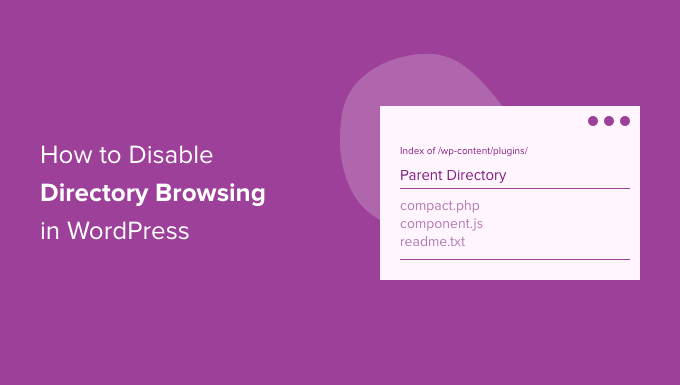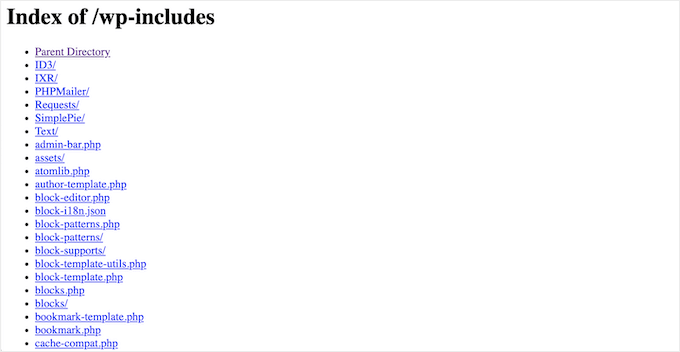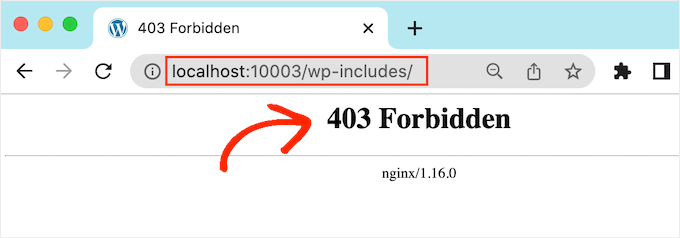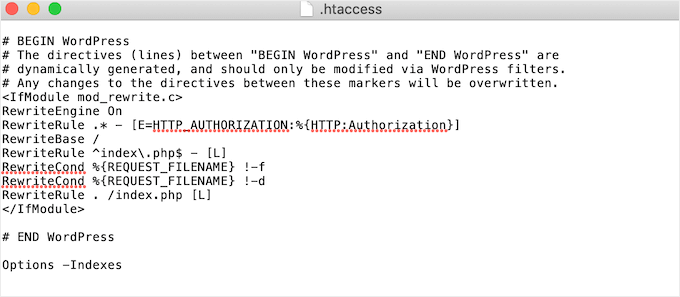Abbiamo visto molti siti web che non disabilitano la navigazione nelle directory. Purtroppo, questo piccolo errore può esporre informazioni sensibili agli hacker e danneggiare un sito web.
L’esplorazione delle directory permette di vedere i file e le cartelle del sito. Gli hacker possono quindi utilizzare queste informazioni per trovare vulnerabilità nei plugin, nei temi o nel server ospitato.
Questo semplice passo può migliorare significativamente la sicurezza del vostro sito. È una correzione rapida che ogni proprietario di sito web dovrebbe conoscere.
In questa guida vi mostreremo come disabilitare la navigazione nelle directory in WordPress. Questo vi aiuterà a proteggere il vostro sito e a tenere al sicuro i vostri dati.

Cosa comporta la disabilitazione della navigazione nelle directory in WordPress?
Quando un visitatore accede a un sito web, il server web elabora la sua richiesta. In genere, il server consegna al browser un file di indice, come index.html.
Se manca un file di indice, il server può visualizzare un elenco di tutti i file e le cartelle presenti nella directory. Questo comportamento, noto come “directory browsing”, è comunemente abilitato in modo predefinito sui server ospitati.
Abbiamo visto in prima persona come la navigazione nelle directory possa esporre informazioni sensibili sulla struttura di un sito. Queste informazioni potrebbero essere utilizzate per identificare vulnerabilità nei plugin, nei temi o anche nelle configurazioni dell’host.
I visitatori possono imbattersi nella navigazione delle directory quando vedono un semplice elenco di file e cartelle invece di una pagina web. Se non viene indirizzato, questo accesso involontario può portare a rischi per la sicurezza.

Gli hacker spesso sfruttano la navigazione nelle directory per visualizzare i file di un sito, compresi temi e plugin. Se uno di questi presenta vulnerabilità note, gli aggressori possono utilizzare queste informazioni per compromettere il sito web.
In molti casi, la navigazione nelle directory può anche esporre contenuti privati o a pagamento, come il download di ebook o corsi online. Questo può portare a copie non autorizzate e a perdite di profitto.
La disabilitazione della navigazione nelle directory è un modo semplice ma efficace per prevenire questi rischi. È uno dei primi passi che consigliamo per mettere in sicurezza un sito WordPress.
Come verificare se la navigazione nelle directory è abilitata in WordPress
Un modo semplice per verificare se la navigazione nelle directory è abilitata sul vostro sito web WordPress è quello di visitare direttamente la cartella /wp-includes/.
Ad esempio, basta inserire nel browser un URL come questo: https://example.com/wp-includes/.
Assicurarsi di sostituire example.com con il dominio del proprio sito web. Questo semplice test funziona con la maggior parte delle installazioni di WordPress.
Se viene visualizzato un messaggio 403 Forbidden o un errore simile, la navigazione nelle directory è già disabilitata. Questo è un buon segno perché significa che il sito web è più sicuro.

Se invece appare un elenco di file e cartelle, la navigazione nelle directory è abilitata.
Ciò rende i siti web vulnerabili ad attacchi dannosi.

Secondo la nostra esperienza, abilitare la navigazione nelle directory espone informazioni sensibili e aumenta i rischi per la sicurezza. Per questo motivo, è meglio disabilitare la navigazione nelle directory in WordPress per mantenere il sito sicuro.
Come disabilitare la navigazione delle directory in WordPress
Per disabilitare l’inserimento nelle directory, è necessario aggiungere del codice al file .htaccess del sito.
Per accedere al file, è necessario un client FTP, oppure si può utilizzare l’applicazione di gestione dei file all’interno del pannello di controllo del proprio hosting WordPress.
Se è la prima volta che utilizzate l’FTP, potete consultare la nostra guida completa su come connettersi al vostro sito utilizzando l’FTP.
Dopo essersi collegati al sito, è sufficiente aprire la cartella pubblica del sito web e trovare il file .htaccess. È quindi possibile modificare il file .htaccess scaricandolo sul desktop e aprendolo in un editor di testo come Notepad.
In fondo al file, è sufficiente aggiungere il seguente codice:
1 | Options -Indexes |
Avrà un aspetto simile a questo:

Una volta terminato, salvate il file .htaccess e caricatelo sul vostro server utilizzando un client FTP.
Questo è quanto. Ora, se si visita lo stesso URL http://example.com/wp-includes/, si otterrà un messaggio 403 Forbidden o simile.

Suggerimento dell’esperto: se sospettate che il vostro sito web WordPress sia stato violato, consultate la nostra guida sulla correzione di un sito web WordPress violato. In alternativa, potete scegliere il nostro servizio di riparazione professionale di siti WordPress violati e assumere esperti di sicurezza WordPress per ripulire subito il vostro sito web.
Ulteriori letture:
Volete mantenere il vostro sito web WordPress sicuro e privo di errori? Potreste trovare utili i seguenti articoli:
- Guida per principianti alla struttura dei file e delle directory di WordPress
- Gli errori più comuni di WordPress e come correggerli
- Come correggere l’errore delle autorizzazioni di file e cartelle in WordPress
- Come proteggere con password la directory dell’amministrazione di WordPress (wp-admin)
Speriamo che questo articolo vi abbia aiutato a capire come disabilitare la navigazione nelle directory in WordPress. Potreste anche voler consultare la nostra guida definitiva alla sicurezza di WordPress o vedere la nostra selezione di esperti dei migliori plugin per la sicurezza di WordPress.
Se questo articolo vi è piaciuto, iscrivetevi al nostro canale YouTube per le esercitazioni video su WordPress. Potete trovarci anche su Twitter e Facebook.





Deepak Kumar
Its work like charm. Article on wpbeginners like ready to go solution. Keep it up.
Ayo
How do I now solve the 404 error that comes after?
Pradip Singh
I am in love with this website. Every day I am surprised when I read a new article from this website. Thankfully I read this article today and immediately I implemented the advice.
WPBeginner Support
Glad you found our content helpful
Admin
Sourabh
Will it block CDNs from accessing my website for static content?
WPBeginner Support
No, it will not.
Admin
sami
Does this method affect google crawling .. is it SEO friendly?
WPBeginner Support
It should not affect search engines crawling your site.
Admin
Meera Shaikh
Thanks its Done
WPBeginner Support
You’re welcome
Admin
Pradeep
Thanks my friend, I just try this and it’s work.
You are the genius.
WPBeginner Support
Glad our guide was helpful
Admin
mousam
Thank you. I applied and it worked.
You guys are the best source for learning wordpress.
WPBeginner Support
You’re welcome, glad our guide was helpful
Admin
Kevine
Thank you very much for this. It solved my problem.
Thanks again.
WPBeginner Support
You’re welcome, glad our guide was helpful
Admin
malika
Thank you for sharing information!
WPBeginner Support
You’re welcome
Admin
Jonthan
So is it ok to have this code on .htaccess file even when an index.php file is present in the root folder.
Kindly respond.
WPBeginner Support
Yes
Admin
Teresa Cuervo
Do you need Filezila to do this or can you go to the FTP via Cpanel and do this?
Thank you
WPBeginner Support
You can use either, not all hosts have a file manager is why we show Filezilla
Admin
michael
Hello
does this action affect pages indexing on search engines?
and does it make some problems for indexed pages of my WordPress website?
Thanks
WPBeginner Support
No, it would not affect that negatively.
Admin
Rhen Castrodes
Thank you. it works
WPBeginner Support
Glad our recommendation was able to help you
Admin
John
Thank you! It works even now in 2020.
WPBeginner Support
You’re welcome
Admin
Shams
Amazing post,
Just have simple question, I added this code and it’s working, the question is Google indexes those page e.g sitecom/wp-contents/2019/2, will Google remove those pages automatically now as these are 404. Or I should remove it in Search Console?
Thanks
WPBeginner Support
This code should not make your direct links to images and files turn into 404s
Admin
Bill
Hello!
I recently applied this rule
and at the same day the front page of my blog
got vanished from google index.
Do you see any connection?
WPBeginner Support
Adding this to your htaccess should not affect your indexing, there are multiple reasons and you would want to check your Google Search Console for what it says about your home page.
Admin
Ionel G
Thanks for all the tips that you provide!
I am still wondering how can you hide the wp-content & wp-include folder from sources? I hate it when someone goes right click and source it can see all of my plugins :). Do you have any script for this?
Thank you in advance!
WPBeginner Support
We do not have a recommended method for that at the moment, the most common reason you can’t see those folders in dev tools is a site’s cache.
Admin
Mayur
Could you please tell me How can i disable WordPress in sub folder like my WordPress install on [www.mydomain.com] and i want to disable wordpress in [www.mydomain.com/customscript]
WPBeginner Support
You may want to first take a look at creating a custom page template: https://www.wpbeginner.com/wp-themes/how-to-create-a-custom-page-in-wordpress/
Otherwise, you would need to create a folder with that name and inside that folder add an index.html file for a nonWordPress page to appear.
Admin
Rafael
Thank you. Worked perfectly for all browsers.
Dipankar
but wp-content is showing . how to remove it as well.
Deatram
I disabled directory browsing, but still someone can see my directory when they use developer tools in chrome browser. How do I disable in that as well?
Faeze
I added the line that you said in .htaccess but it showes my directories yet .
What should I do now??
Nathan
When I click “Save Changes” on the Permalink Settings page the .htaccess file is updated, erasing the “Options -Indexes” code that I inputted. The code works fine, but I am concerned I will unknowingly delete it while performing some other task. Are there any other dashboard settings changes that I should know about that may affect the .htaccess file and erase the code? Thanks
Tôi Sống
Awesome, it work very good!
Baggio
Huge fan of wpbeginner, Optin Monster – I got so many useful tips and tricks on WP – and I have to say, the site design is just brilliant. And of course, the content here is epicly useful.
Thanks guys!
daniel
Hey! It doesnt seem to work. if i pull an image to another page its opened with a link of: example.com/wp-content/uploads/…
Any idea? thanks!
WPBeginner Support
Hey Daniel,
Your images and files inside directories can still be directly accessed. However, server will not let someone directly browse a directory and see its contents.
Admin
Axel Jebens
I would appreciate if you could iterate on this. I had a hard time when trying to get a solution for this issue. There are some ideas based on a htaccess redirecting to a php file that first checks if the user is logged on. Is there any plugin which provides such a function?
Ünal Hoca
Thank you
Khalid Mahmud
Thank you. It’s working…….
Kim
Sorry to late ask. I want to know, are these techniques safe to use regarding SEO score ? Hope you answer !
WPBeginner Support
Yes, they are.
Admin
Kimmy
Still works pretty well. Awesome, simple, and working. Thanks!
Charles
I have been writing this same code for weeks now but my directory remains visible to users. Pls what am doing wrong? Or could it be that my site is still loading from cached contents? Everybody says it is working but my own experience is different. Any help will be appreciated! Thanks in anticipation of your reply.
Kimmy
What part are you having trouble on? What is your hosting provider btw?
Lily
Thank you. Worked like a charm!
Prakash
This Above Trick Is Not Working Man….
Mike
Is there a way to allow viewing a directory but just hide the Parent Directory link for a specific page? This would be a network share folder that multiple people would access, and have sub folders which would still require a parent directory listing. I just don’t want anyone going above the shared folder.
Christian Nastari
This didn’t work for me. I tried before and after #END WordPress and didn’t work. I also tried “Options All -Indexes”, but didn’t work either
hrwhisper
very helpful, thank you very much
nitai
Really great. today I just faced and thinking how can I disallow like joomla and I found the exact solution.
Rob Myrick
This was very helpful and quick – thank you
Anita in SD
Thanks so much, was dismayed to see images from my site going to a parent directory :0. This was very helpful and worked well.
Blessings – A
Heather Jacobsen
Thanks for this tutorial. It worked great for hiding my uploads from anyone just wanting to browse that directory. One question, though. Does this by chance turn off the ability of search engines to browse my website. Sorry if it seems like a dumb question. I am a newbie, after all.
Wasil Burki
I added the Options -Indexes code to the htaccess file, however now I am not able to access the site I get a 503 error. Am I doing something wrong? Need help bad!! Thanks
Ted
The problem I have is that I can see the directory of this wordpress site, so if you are using this solution then it doesn’t work… (theme wpbv4)
Rahul
Thank you so much for the tutorial!
I was very concerned when I discovered some of my theme directories could be browsed. All good now, thanks to your tutorial. I never knew .htaccess packed in so much punch.
KeelAha
Hello Syed Balkhi
I just noticed that one of your site list25.com having directory browsing enabled on following folder.
Not sure if that is important to you.
http://list25.com/wp-includes/
Have a great weekend and keep doing your good work.
regards
KeelAha
WPBeginner Support
Disabled it, thanks
Admin
Logan
Why do I get a blank page, and not an error when I try to access the ../wordpress/wp-content/ or ../wordpress/wp-content/plugins/ ?
WPBeginner Support
It may depend on your theme or your hosting environment. Try enabling directory browsing and then access these directories. If you still get a blank page then this means that those directories have a blank index.php file in them.
Admin
Charlie Sasser
I tested this before I made any changes with a location that didn’t have an index.php or .htm file and yes you can see all of the files. I added the suggested line at the end of the .htaccess. The location now creates a 403 error from the host and not a 404 error from WordPress. I’m running WP 3.8. Is this the expected behavior?
Bern
I have the same issue it shows 403 error not 404. Did you solve this problem?
Christian
Same issue appear, what to do now? using latest version of wordpress.
Abhisek
Better WordPress Security plugin takes care of that.
Govinda
How do I do it in Better Wp security.
I have installed the plugin, but not able to find this feature
Costin
Hi,
Could you please tell me if “Options All -Indexes” is the same or better?
Thank you!
WPBeginner Support
Its the same.
Admin
David Trees
Thanks for this important information.
Do you mean;
Here
Options -Indexes
# END WordPress
OR
# END WordPress
Options -Indexes
Thanks for your reply.
Cheers
David
WPBeginner Support
Both should work the same but we meant the later one after the END WordPress
Admin
Ivan R Linares
Thank you, worked like a charm!